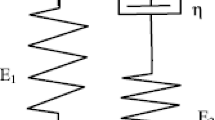Abstract
Polyurethane (PU) and other plastic foams are widely used as passive acoustic absorbers. For optimal design, it is often necessary to know the viscoelastic properties of these materials in the frequency range relevant to their application. An experimental/numerical technique has been implemented to determine the Young and shear dynamic moduli and loss factor of poroelastic materials under low-frequency 40–520Hz random excitation. The method consists of measuring the dynamic response of the sample at its surface, and matching the response with the predictions from a finite element model in which the two complex elastic moduli are the adjustable parameters. Results are presented for measurements made in air, under standard pressure and temperature conditions, and compared with predictions based on Okuno’s model. The dependence of elastic moduli on the dimension of the sample and its boundary conditions is also studied.
Similar content being viewed by others
References
J. F. Allard, Propagation of Sound in Porous Media: Modeling Sound Absorbing Materials, Chapman and Hall, London, (1993).
M. A. Biot, Theory of propagation of elastic waves in a fluid-saturated porous solid. I. Low-frequency range. II. Higher frequency range, Journal of the Acoustical Society of America 28 (1956) 168–191.
R. D. Corsaro and L. H. Sperling, Sound and Vibration Damping with Polymers, ACS Sympoisum Series, Washington DC, USA. (1990).
S. Oyadiji and G. Tomlimson, Determination of the complex moduli of viscoelastic structural elements by resonance and non-resonance techniques, Journal of Sound and Vibration 101 (1985) 277–298.
W. M. Madigosky and G. F. Lee, Automated dynamic Young’s modulus and loss factor measurements, Journal of the Acoustical Society of America 66 (1979) 345–349.
W. M. Madigosky and G. F. Lee, Improved resonance technique for material characterization, Journal of the Acoustical Society of America 73 (1983) 1374–1377.
S. L. Garrett, Resonant acoustic determination of elastic moduli, Journal of the Acoustical Society of America 88 (1990) 210–221.
J. Ferry, Viscoelastic Properties of Polymers, Wiley, New York, (1970).
R. L. Willis, T. S. Stone, and Y.H. Berthelot, Determination of the complex Young and shear dynamic moduli of viscoelastic materials, Journal of the Acoustical Society of America 109 (2001) 611–621.
Y. J. Kang and J. S. Bolton, Finite element modeling of isotropic elastic porous materials coupled with acoustical finite elements, Journal of the Acoustical Society of America 98 (1995) 635–643.
A. Okuno, Dynamic Response of Structures Containing Poroelastic Materials, Ph.D. Thesis, School of Mechanical Engineering, University of Delaware, (1986).
N. M. Shiau, Multi-dimensional Wave Propagation in Elastic Porous Materials with Application to Sound Absorption, Transmission and Impedance Measurement, Ph.D. Thesis, School of Mechanical Engineering, Purdue University. (1994).
Y. J. Kang and I. H. Jung, Sound propagation in circular ducts lined with noise control foams, Journal of Sound and Vibration 239 (2001) 255–273.
W. H. Press, B. P. Flaneery, S. A. Teukolsky, and W. T. Vetterling, Numerical Recipes, Cambridge U.P., Cambridge, (1992), Sec. 10.5.
J. Jarzynski, Mechanisms of sound attenuation in materials, Sound and Vibration Damping with Polymer (edited by R. D. Corsaro and L. H. Sperling) ACS Sympoisum Series, Washington DC, USA. (1990), 167–207.
Author information
Authors and Affiliations
Corresponding author
Additional information
This paper was recommended for publication in revised form by Associate Editor Hong Hee Yoo
Professor Yeon June Kang received his B.S. and M.S. degrees in Mechanical Design and Production Engineering from Seoul National University in 1988 and 1990, respectively. He then went on to receive a Ph.D. degree in Acoustics and Vibra-tion from School of Mechanical Engineering, Purdue University in 1994. After his Ph.D., he continued to work as a Postdoctoral Research Associate at Ray W. Herrick Laboratories, Purdue University until 1996. Since 1997, Dr. Kang is working at the Department of Mechanical and Aerospace Engineering, Seoul National University. Dr. Kang’s research interests are in the area of acoustical materials, noise and vibration in automotive engineering, and Korean Bells.
Rights and permissions
About this article
Cite this article
Hamza, A., Kang, Y.J. Hybrid experimental/numerical technique for determination of the complex dynamic moduli of elastic porous materials. J Mech Sci Technol 23, 283–290 (2009). https://doi.org/10.1007/s12206-008-0715-z
Received:
Revised:
Accepted:
Published:
Issue Date:
DOI: https://doi.org/10.1007/s12206-008-0715-z




